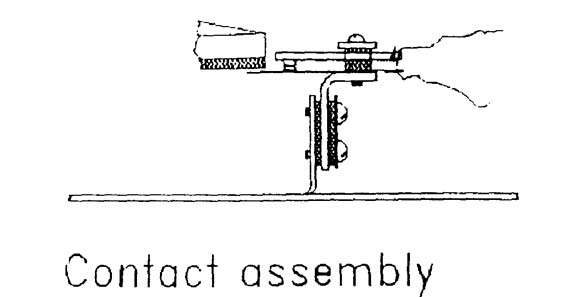RIST HORN INTERIORS
From an article by Mike Phelan reproduced from the Pre War Austin 7 Club Newsletter of October 1988 with many thanks
As replacement casings for Rist horns are now readily available, I
thought that a small article on the internal construction and adjustment might
be useful, especially to those
 who
are making a new horn to replace one which is completely missing. The
construction is fairly simple and the horn may be made from scrap box materials.
It is important that the coil former and armature are made from soft iron rather
than steel. The latter will eventually develop residual magnetism which will
impair efficiency. The springs can be pieces of old clock spring or hacksaw
blade and it may be necessary to fit more or less than four, depending on the
elasticity of the materials used.
who
are making a new horn to replace one which is completely missing. The
construction is fairly simple and the horn may be made from scrap box materials.
It is important that the coil former and armature are made from soft iron rather
than steel. The latter will eventually develop residual magnetism which will
impair efficiency. The springs can be pieces of old clock spring or hacksaw
blade and it may be necessary to fit more or less than four, depending on the
elasticity of the materials used.
The number of turns on the coil is not critical and the contacts can be any old set of points, relay or cut-out contacts etc. Mild steel can be used for the armature spindle, which can have its top end slotted to ease adjustment. Fit shake-proof washers throughout. The adjustment is rather critical. Horns of this period operate on a different principle to later ones of the thirties. The sound is produced by the armature spindle striking the diaphragm, the trumpet amplifying the sound. Later horns have the armature directly attached to the diaphragm and a tuned steel disc that resonates to one of the harmonics of the vibration frequency.
The diaphragm must be a plain disc of spring steel, free from paint
or dirt, supported between two paper gaskets. The armature must have about 2 mm
movement before the
 spindle
contacts the diaphragm. At this point, there should be a gap of 2 - 4 mm between
the fibre disc and the pole face, and the contacts should be just about to open.
Bend the contact bracket for loudest sound. Stuff a rag into the trumpet whilst
testing to make it more bearable for your neighbours! Lock all nuts with paint
when complete.
spindle
contacts the diaphragm. At this point, there should be a gap of 2 - 4 mm between
the fibre disc and the pole face, and the contacts should be just about to open.
Bend the contact bracket for loudest sound. Stuff a rag into the trumpet whilst
testing to make it more bearable for your neighbours! Lock all nuts with paint
when complete.
 Mike
Phelan
Mike
Phelan
